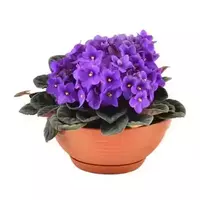Violet flowers

As early as the 17th century, the French poet Demaret spoke of the violet: "From the most modest flower I will turn into the proudest, " which is evidence that this beautiful flower has long inspired writers, poets and artists, considered a symbol of flirtation and seduction.
Meanwhile, violet (Viola) is a herbaceous perennial plant that belongs to the Violet family. This is not only an unusually beautiful plant, which is usually grown for decorative purposes, but also a food product, no matter how strange it may sound.
For example, historical facts come to this day that it was candied violet petals that were a favorite treat of everyone's beloved Austrian Empress Elizabeth of Bavaria, who is also known under the name Sissi. But the tradition of various kinds of treats based on violet colors originated in 1960 in the city of Toulouse, in France.
In confectionery, violet flowers are still used today - they are mainly used to flavour drinks and sweets. The aromatic properties of violet are used to give a unique aroma to sugar. In addition, pastries, cakes or ice cream are often decorated with fresh flowers. Today, violet flowers can also be found in jams and jam, they are often added to marinades. And to decorate drinks, violet flowers are usually frozen in ice cubes.
Types of violets
The European part of Russia is characterized by the growth of about 20 species of violets, among which most often there are: swamp violet, Wittroka or garden pansies, fragrant, pubescent, one-flowered, field, dog, poplar, tricolor, amazing and two-flowered.
In addition, some other types of violets are common in North America, namely Canadian violet, hooked-curved violet and horned violet.
Violet composition
It has been found that violets (especially plant shoots) contain such active substances as anthocyanin and flavon glycosides, inulin, saponins, essential oils, carotenoids, tannins and polysaccharides. Meanwhile, violet roots contain the alkaloid violaemethine.
Benefits of violet
The benefits of violet for human health are due to its composition, thanks to which the plant has an exhilarating, diuretic and anti-inflammatory effect (this is especially typical for tricolor violet).
In alternative medicine, the benefits of violet are relevant in the treatment of colds, vitamin deficiency, metabolic disorders, diseases of the urinary tract and kidneys. In addition, medicinal products based on this plant help in the therapy of joint diseases, coronary heart disease, vascular atherosclerosis, infectious diarrhea and epilepsy.
Harm of violet
Contraindications to the use of violet-based drugs, as well as the flowers themselves, are hepatitis and glomerulonephritis. In addition, the long-term use of such drugs can provoke harm to the violet for the human body, which consists in the likely attacks of nausea, vomiting and itchy rash.
violet colors 0 kCal
Energy value of violet flowers (Ratio of proteins, fats, carbohydrates - ju):
Proteins: 0 g (~ 0 kCal)
Fats: 0 g (~ 0 kCal)
Carbohydrates: 0 g (~ 0 kCal)
 Español
Español Français
Français Português
Português Русский
Русский 简体中文
简体中文 繁體中文
繁體中文 日本語
日本語 한국어
한국어 العربية
العربية Türkçe
Türkçe Қазақ
Қазақ Deutsch
Deutsch Italiano
Italiano Українська
Українська
